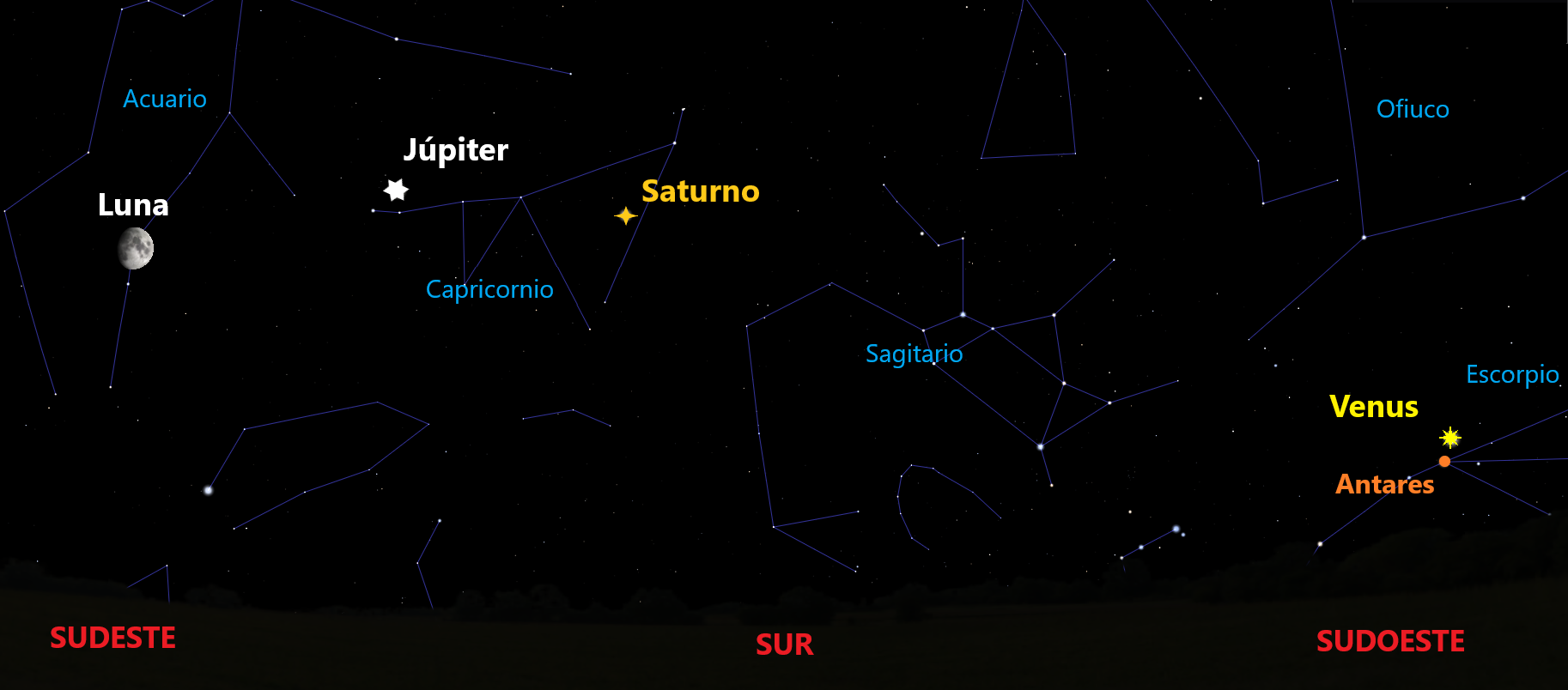Interview "Many of the changes in the environment are irreversible"
Chronicles of the cosmos A rare circumtriple planet in the head of Orion
After sunset, this weekend we can enjoy some beautiful celestial scenes formed by three planets.
Venus
will be close to Antares, while
Jupiter
and
Saturn
, further east, will be close to the crescent moon.
Venus with Antares
This weekend it is convenient to be vigilant after sunset. Barely an hour has elapsed since the Sun has set over the western horizon, it is convenient to look up to the southwest to admire the splendid glow of Venus. And very close in the sky, at a slightly lower elevation,
the twinkling brightness of the star Antares will become more and more apparent
as the sky darkens. Both stars are separated by an apparent distance equal to twice the diameter of the full moon.
Antares, the brightest star in the zodiacal constellation Scorpio, is a red supergiant located about 550 light-years away.
Its luminosity exceeds 10,000 times that of our sun.
Its size is so enormous that, if it were to occupy the place of the Sun, in the center of our solar system,
Mercury, Venus, Earth and Mars would remain under the star
surface, a surface that would include an area located on the outer edge of the belt. of asteroids, already close to Jupiter.
But despite being so bright and huge, being 45.6 million times farther away than Venus, Antares is shown to us with a brightness that is
about 150 times less than that of our sister planet
.
Antares now appears close to the line of sight to Venus because it is located in an area of the sky close to the ecliptic, the imaginary line on which we observe the planets (and other objects) of the solar system.
At other times of the year, it appears near other planets.
Thus,
every 23 months, Antares is located near Mars (Ares in Greek)
and then it becomes clear that both stars have a brightness of the same reddish hue.
From this, and from its proximity every almost two years, comes the name of the star: anti Ares, Ares's rival, since it comes to rival Mars in prominence.
The three planets visible after twilight.Stellarium / RB
Ecliptic
Once we have observed Venus, when the sky is already dark, let's look to the southeast.
In that area of the sky, we will see Jupiter, on the border between the constellations of Aquarius and Capricorn.
Jupiter is now the brightest star in the sky after the Moon and Venus.
And to the right of Jupiter, as we look at the sky, we can also see
Saturn, much weaker and redder
.
We can now materialize the ecliptic line by joining the apparent positions of Jupiter, Saturn and Venus.
But remember that these planets are located
at very different distances
: Venus is now 114 million kilometers from Earth, while the distances to Jupiter and Saturn are 670 and 1.45 billion kilometers, respectively.
The two gas giants gain height as the night progresses and hide at dawn in the west. In the middle of the night, they are at about 50 degrees elevation in unbeatable conditions for observation from Spain. In astronomical terms: Jupiter's magnitude is now -2.7 and its apparent diameter measures 45 arc seconds (about 40 times less than that of the full moon). Saturn's magnitude is now 0.5 and its apparent diameter is 17 arc seconds. This is equivalent to saying that
Jupiter looks about 19 times brighter and has an apparent size 2.6 times
that of Saturn.
This weekend,
the Moon is already very bright
because the next full moon will take place on the 20th. On Saturday the 16th and Sunday the 17th we will be able to see it more and more to the east of Jupiter, following the direction of the ecliptic.
Where are Mercury and Mars?
These days the little Mercury is also observable for a short time at dawn in the east, one hour before the sun rises. That is, it should be observed around 07:30 in the morning (peninsular time) and, as always,
from a place that has a horizon well clear
of obstacles such as mountains, trees or buildings.
However, Mars is still close to the direction of the Sun and
is not observable
at this time.
We will have to wait until December to see it appear, at very low elevations, at dawn in the southeast.
Rafael Bachiller
is director of the National Astronomical Observatory (National Geographic Institute) and academic of the Royal Academy of Doctors of Spain.
According to the criteria of The Trust Project
Know more
science
Science and Health
ScienceThree Chinese astronauts return to Earth after 90 days building their space station
ScienceChange of time 2021: when to change the time to winter time
Cumbre ViejaVolcán on La Palma, latest news of the eruption live |
Two new "very effusive" mouths are opened in the La Palma volcano and the lava now occupies 709 hectares
See links of interest
The Palm
Last News
What
Work calendar
How to get a digital certificate
Home THE WORLD TODAY
Master Investigation Journalism
AS Monaco - Barça
TSG Hoffenheim - 1. FC Cologne
Real Madrid - Panathinaikos
Paris Saint-Germain - Angers
Eibar - Almeria

